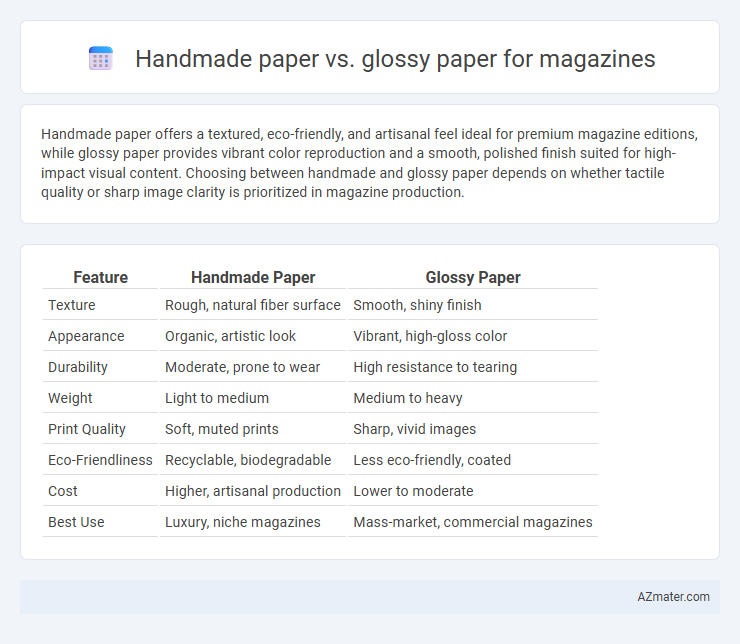Handmade paper offers a textured, eco-friendly, and artisanal feel ideal for premium magazine editions, while glossy paper provides vibrant color reproduction and a smooth, polished finish suited for high-impact visual content. Choosing between handmade and glossy paper depends on whether tactile quality or sharp image clarity is prioritized in magazine production.
Table of Comparison
| Feature | Handmade Paper | Glossy Paper |
|---|---|---|
| Texture | Rough, natural fiber surface | Smooth, shiny finish |
| Appearance | Organic, artistic look | Vibrant, high-gloss color |
| Durability | Moderate, prone to wear | High resistance to tearing |
| Weight | Light to medium | Medium to heavy |
| Print Quality | Soft, muted prints | Sharp, vivid images |
| Eco-Friendliness | Recyclable, biodegradable | Less eco-friendly, coated |
| Cost | Higher, artisanal production | Lower to moderate |
| Best Use | Luxury, niche magazines | Mass-market, commercial magazines |
Introduction to Handmade and Glossy Papers
Handmade paper, crafted from natural fibers through traditional methods, offers a textured, organic feel that enhances the tactile experience of magazines, promoting sustainability and unique aesthetics. Glossy paper, coated with a smooth, shiny finish, delivers vibrant colors and sharp images, making it ideal for high-quality photographic and commercial magazine prints. Choosing between handmade and glossy paper depends on the desired visual impact, print quality, and the environmental values of the publication.
Defining Handmade Paper: Features and Creation
Handmade paper is crafted through a meticulous, manual process using natural fibers like cotton or hemp, resulting in a distinctive texture and irregular thickness that adds tactile depth to magazine pages. Unlike glossy paper, handmade paper exhibits a matte, porous surface that enhances ink absorption and creates an artisanal, organic aesthetic. Its environmental sustainability and unique fiber patterns make it a preferred choice for high-end, eco-conscious magazine publications seeking a premium tactile experience.
Glossy Paper Explained: Characteristics and Production
Glossy paper, commonly used in magazines, features a smooth, shiny surface achieved through coating with clay or polymer materials, enhancing color vibrancy and image sharpness. The production process involves applying multiple layers of coating followed by calendaring to create a reflective finish, increasing durability and resistance to wear. This high-quality finish makes glossy paper ideal for showcasing detailed photographs and graphics with vivid color reproduction.
Aesthetic Appeal: Visual Differences
Handmade paper offers a unique, textured surface that enhances the tactile and visual richness of magazine pages, creating an artisanal, organic look that appeals to luxury or niche markets. Glossy paper delivers a smooth, reflective finish with vibrant colors and sharp details, ideal for magazines that emphasize high-quality photography and bright visuals. The visual difference lies in handmade paper's matte, irregular surface versus glossy paper's sleek, polished appearance, influencing reader perception and magazine style.
Texture and Tactile Experience
Handmade paper offers a unique, textured surface that creates a rich tactile experience, enhancing the sensory appeal of magazines through its organic, fibrous feel. Glossy paper provides a smooth, reflective finish that delivers vibrant color reproduction and sharp images but lacks the tactile depth found in handmade alternatives. Choosing between these papers impacts not only the visual impact but also how readers physically engage with the magazine.
Printing Quality and Color Reproduction
Handmade paper offers a unique texture that enhances the tactile experience but can challenge printing quality due to its uneven surface, leading to less precise color reproduction. Glossy paper provides a smooth, reflective finish that maximizes ink absorption and sharpness, resulting in vibrant, true-to-life colors ideal for high-resolution magazine images. Choosing glossy paper ensures consistent, bright color output, making it the preferred option for magazine covers and photo-heavy spreads.
Environmental Impact and Sustainability
Handmade paper, produced using traditional methods with recycled fibers, offers superior environmental benefits by reducing chemical usage and minimizing carbon footprints compared to glossy paper, which relies on petroleum-based coatings and intensive manufacturing processes. Glossy paper often involves non-recyclable finishes and higher energy consumption, contributing to greater landfill waste and pollution. Selecting handmade paper enhances sustainability efforts by promoting biodegradability and supporting eco-friendly practices in magazine production.
Cost Comparison: Handmade vs Glossy Paper
Handmade paper generally incurs higher production costs due to labor-intensive processes and raw material expenses, making it a premium choice for magazines seeking unique texture and artistic appeal. Glossy paper, produced through machine processes with coating layers for shine and durability, offers a more cost-effective solution for high-volume magazine printing and vibrant image reproduction. While handmade paper elevates exclusivity and eco-friendliness, glossy paper remains the budget-friendly option optimizing cost-efficiency and print quality.
Best Uses in Magazine Publishing
Handmade paper is ideal for high-end, artisanal magazines seeking a unique tactile experience and eco-friendly appeal, often used in limited editions or art publications to emphasize craftsmanship and texture. Glossy paper excels in mainstream magazine publishing by enhancing vibrant colors and sharp imagery, making it perfect for fashion, lifestyle, and advertising-rich content where visual impact drives reader engagement. Choosing between handmade and glossy paper depends on budget, target audience, and the desired aesthetic, balancing luxury feel against mass-market appeal.
Choosing the Right Paper for Your Magazine
Handmade paper offers a unique tactile experience with its textured surface, enhancing the artistic and eco-friendly appeal of a magazine, ideal for niche or luxury editions. Glossy paper delivers vibrant colors and sharp image quality, making it perfect for magazines focused on high-impact visuals and mainstream audiences. Selecting the right paper depends on your magazine's brand identity, target audience, and the desired visual effect to ensure maximum reader engagement and durability.

Infographic: Handmade paper vs Glossy paper for Magazine
 azmater.com
azmater.com